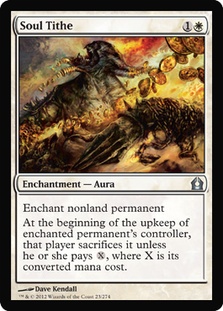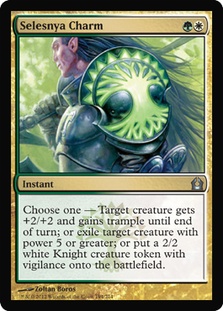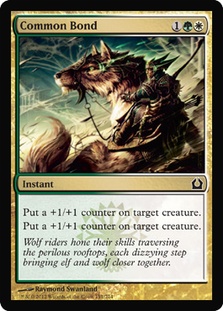For Selesnya Week, I’m going to write about drafting the guild. I hate to be wrong, so I need to be upfront about a few things. I’ve drafted this set twice and once was W/G/U. I’ve played with the cards, but this is not one of those articles I write after dozens of drafts where I come to tell you about an awesome deck or draft style I’ve come up with. This is the first guild theme week. The set hasn’t been released yet, and I couldn’t play in the Prerelease due to illness.
However, I’m aware of the limitations I’m working with, and I’m excited to write about this because I still think I can bring a lot to the table. The obvious advantage to writing so early is that all of you also have less experience, so any information at all is more valuable. Also, as has been my focus in Constructed articles and videos lately, I really believe in showing my process to really teach how I’m thinking about the game, so I think there’s a lot of value to seeing how I approach figuring a set out in the beginning rather than merely receiving instruction at the end once I’ve figured something out. So the focus here will largely be on approaching the set on a theoretical level, tempered by some valuable experience.
First, some background. While the roles each color pair plays shifts somewhat from set to set, there are always similarities in how any pair of colors play together from one set to another that are rooted in the basic strengths and weaknesses of those colors in the color pie. If you understand how green/white plays in a few Draft formats, you can create a realistic expectation of what will happen in future formats.
That said, there are very real differences, and they’re particularly pronounced in single set formats where the exact commons can matter a great deal.
Green/white decks are always going to be about creatures, obviously, but the pacing can change a lot. Also, the strength of this color pair is more volatile than some color pairs. U/W is almost never bad, for example, but G/W has been decidedly the best color combination (Innistrad) or decidedly the worst (Onslaught). It’s valuable to understand why it’s good when it’s good or bad when it’s bad to figure out both how good it’s likely to be in a new format as well as what to watch out for or look for when drafting it.
What are the primary variables to G/W’s success?
G/W is often defined by its inability to remove a creature from play. Usually, the best it can hope for is something like Pacifism, which will keep a creature out of combat but can still use its abilities. Sometimes white will have something like Oblivion Ring or Arrest, but even when it does it’s often at uncommon. Recently, green has had Prey Upon, but that’s far from the norm.
Sometimes that’s a bigger problem than others. That’s entirely a function of whether keeping a creature out of combat is enough to avoid losing to it. Onslaught was full of creatures that would win the game if left unchecked, like Sparksmith and Wirewood Savage (among many, many others). This meant playing a deck without red or black was extremely difficult and dangerous.
Recently, there have been fewer common “healers,” “pingers,” and “tappers,” which is excellent news for G/W. Those were the most common utility creatures, and they could pose a huge problem if the opponent had them since they could fairly easily make all combat unfavorable for you and combat was really the only way you had to win or even interact.
Return to Ravnica continues this trend. Instead of creatures having reusable activated abilities to disable each other, Azorius has creatures with the enters the battlefield ability detain, which happens only once and doesn’t punish you in any way for not being able to remove the creature. Guildmages are a counterexample, but they’re uncommon and G/W as an excellent one of its own.
This is to say that Selesnya in Return to Ravnica easily passes the first basic playability test. It has a good amount of removal compared to its average (Avenging Arrow and Trostani’s Judgment at common, and Arrest and Soul Tithe at uncommon in white and Aerial Predation in green), and it doesn’t need very much.
So what is its character or pacing in this set?
In Innistrad, G/W was generally an extremely aggressive deck with a very low curve that just wanted to attack every game. Contrast this with a set like M13 where, at least to my way of thinking, G/W wanted to lock up the board, play a bunch of giant five-mana creatures, and then pound through with a handful of tricks or bombs. Basically, you can focus on early defensive creatures and late big creatures, or you can focus on early aggressive creatures and tricks. Both colors are potentially excellent at both strategies.
In Return to Ravnica, both colors actually seem well positioned to do both of these things, and I think there are essentially two very different Selesnya decks available and both are deeply supported. I have this opinion based on drafting and playing the set rather than based on a detailed analysis of the numbers. I’m going to assume this is correct as I work through the detailed analysis until I find something in the numbers that disproves this theory.
I want to try to offer some guidelines about how to draft this color combination in this set, but it’s important to understand that this color combination has (at least) two radically different decks and which one you’re in will change which cards you’re looking for completely, so it’s important to try to get a feel for which deck you’re drafting as soon as possible I’d imagine. Either that or to stay very flexible. (As an aside, I had the exact same experience drafting Izzet. It was clear that I could be drafting aggro or control, and difficulty choosing which one I was was my biggest weakness in a draft where all the cards were coming to me.)
With that basic understanding, let’s talk about the decks.
Drafting Selesnya Aggro
This deck is going to want cheap creatures and a lot of tricks. In my experience in the past, I’d say it actually doesn’t matter all that much how good the creatures are if you have good tricks—the most important thing is your curve. You want to start attacking as soon as possible and never let your opponent have profitable blocks or stop you from attacking with your entire team. Historically, this means I’d like to play fifteen or sixteen lands and around seven combat tricks in a perfect world, but that is an extreme case.
The reason I believe this deck exists in that there are an absurd number of combat tricks in this format:
Swift Justice
Chorus of Might
Giant Growth
Savage Surge
Common Bond
Selesnya Charm
That’s four common and two uncommon pump spells, and that’s before considering Rootborn Defenses and Druid’s Deliverance, which both relevantly change combat at instant speed (to say nothing of the fact that they (and a number of other cards) can create instant blockers if you have a token.
With all those tricks, it shouldn’t be hard to kill any creature that ever enters combat with one of your creatures.
The best part is that these tricks are all pretty good and extremely different, so it’s very hard for your opponent to play around them. Even if their game plan is to just block and if you have it at least you’ve used it, if your trick was Common Bond the bonus sticks around, so they really get punished for running into it.
Swift Justice looks relatively unassuming because it’s just +1/+0, but the lifelink is incredible. Moment of Heroism was excellent, and while this card is much weaker, costing less mana is a huge deal. Much more importantly, I think the life gain will prove to be far more important in this format.
In Innistrad, G/W was almost the only game in town when it came to beating down. Every now and then you’d find a Vampire aggro deck, but they didn’t generally fare well when it came to racing G/W because G/W’s creatures were just bigger. Well, unleash changes that. Rakdos is where the big guys hang out now, and Azorius can use detain to try to win a close race with evasion. This won’t be your aggro deck against their control deck. You’ll very often find yourself playing your aggro deck against their different kind of aggro deck. And since Rakdos can’t block, and you can’t block Azorius’ creatures, the race is basically just going to come down to damage output, but life gain from Swift Justice can put you a turn ahead.
Chorus of Might is a very different kind of card. This isn’t a normal trick because four isn’t a normal casting cost for a trick. This card is best when it’s basically a finisher, and it’s not really intended for you, the aggro deck. It’s serviceable, but it’s really there for the populate deck, who it will give a much bigger bonus to. You can play one or two, but I’d probably be looking to pick up the cheaper removal first.
Savage Surge is the worst of the pump spells by a reasonable margin. You’re paying more mana than Giant Growth for less bonus. In exchange, you get to untap the creature, but as I just discussed blocking is rare here, so ambushing someone by untapping won’t come up all that often. The fact that it’s uncommon helps a little in that people won’t play around it much, but if you have a token creature, they might already by playing around the fact that you could have one more blocker than it looks like because you could potentially populate.
Besides, if everything’s going well you don’t have to block and your opponent does, so you’ll get to use all your tricks to kill their guys anyway. There’s no reason to pay a premium to do it.
Selesnya Charm and Common Bond are both absurd. These are high picks, reasons to be this deck, and rewards for being this deck later on. Selesnya Charm does everything, and it does it all very well. Common Bond—I don’t even know what to say about these cards. They just couldn’t be any better at doing what they do, and what they do is fairly obvious. If your deck was just eight Plains, eight Forests, six Common Bonds, and eighteen Selesnya Charms, you’d probably do alright, although I’d definitely rather have some one- and three-mana creatures.
How do the creatures look for this plan?
Among commons and uncommons, the following are the creatures you’re hoping to play as many of as you can:
Azorius Arrester
Fencing Ace
Sunspire Griffin
Brushstrider
Call of the Conclave
Centaur Healer
Dryad Militant
Judge’s Familiar
Vassal Soul
These are the creatures you really want, and for the most part, you want them a lot more than most other drafters. These are mostly vanilla bodies with good aggressive stats. Other players will be looking for sweet abilities, but you just want numbers. The tricky things your creatures do come from pump spells. Centaur Healer is a great example of a card that is good for any Selesnya deck but, maybe slightly counterintuitively, is a much higher pick for you.
The reason I say it’s counterintuitive is that traditionally control decks are the ones that are looking to gain life, but I think that so many people in this format are looking to attack that aggro decks become racing decks, so life gain is huge. The control decks are largely concerned with board presence, so a onetime gain of three life doesn’t really help them stabilize the way they need to. They’d much rather have something like a Security Blockade, which you have no interest in.
These are cards that have fine stats and would be willing to play to fill out your curve, but they’re not as good or not really for you because someone else wants them much more than you do:
Vitu-Ghazi Guildmage *
Keening Apparition
Selesnya Sentry
Trained Caracal
Drudge Beetle
Golgari Decoy
Korozda Monitor
Stonefare Crocodile
Slitherhead
Concordia Pegasus
Eyes in the Skies
Seller of Songbirds
Azorius Justiciar
*Obviously, you’d love to have Vitu-Ghazi Guildmage, you’d take it over almost everything on the first list, and you’d never cut it, but it’s so much better in the other kind of Selesnya deck that I think you’re rarely going to end up with it. After all, if you get it early, why aren’t you just drafting a populate deck?
The others are all just fine costs for the bodies they provide. They’re not especially aggressive, but they can get the job done. I’d take basically any trick over any of them early, and later I’d only take them over tricks if I was particularly low on creatures in general or at their point in my curve.
The basic pick order is something like Bomb > Common Bond or Selesnya Charm > A-list creature> Other trick or removal spell > B-list creature > other appealing spell > filler creature on curve
Later in the draft if you’re having serious curve or creature or spell count issues, things can change around, but that’s basically what I’d be looking to do here. Remember that these lists are pretty rough and may contain oversights. As with everything here, pay more attention to the concepts and take the details with a grain of salt.
Drafting Selesnya Control
… Or ramp, or populate…
Here’s where we use the other green and white cards.
Because we’re not trying to kill our opponent as fast as possible, we have to understand that there’s a good chance that they are trying to kill us as fast as possible so we need to prioritize staying alive very highly. Remember that blocking in this format is possible but extremely difficult, as discussed earlier. Still, at some point you’re probably going to have to block or at least have enough big guys that the threat of blocking stops your opponent from attacking. Once you’ve done that, you’ve already basically won a lot of your matchups. So few others are in the business of blocking that once you’re ready to go on offense they should die fairly quickly.
There will be times when you play against other decks that are playing for the long game. Understand that when this happens, both of you are (I think) going against the basic direction of the format, which probably means both of you have a reason to do so, which probably means both of you opened powerful late game cards. This means you’re going to have to hope yours is better or you draw yours and they don’t draw theirs. Either way, your fundamental plan of making a bunch of big creatures and eventually overwhelming with them is generally pretty sound.
So, as I said, you probably have some bomb you’re stalling to. There’s a good chance it lets you populate multiple times, and that’s the end game we’re trying to set up. If that’s what’s happening, obviously you want to pay attention to getting tokens to populate. It’s not that easy to stumble into a bunch of token producers, but if you’re not getting cut, you should be able to find enough. You need to prioritize removal very highly. Blocking doesn’t get the job done—killing their guy does. Avenging Arrow is a horrible card if you’re the aggro deck, but if you just want to take control, it gets the job done reliably.
You want nothing to do with vanilla bodies that aren’t tokens or huge. You’ll have more than enough of that from your tokens—leave those to the aggro decks.
You’ll still want a few tricks to function as removal spells to give you time, but you’re looking for more like one to three of them rather than five to eight.
Among commons and uncommons, the most important cards for you are:
Arrest
Avenging Arrow
Phantom General
Security Blockade
Soul Tithe
Trostani’s Judgment
Axebane Guardian
Centaur’s Herald
Slime Molding
Call of the Conclave
Coursers’ Accord
Selesnya Charm
Vitu-Ghazi Guildmage
I already discussed the importance of removal. Security Blockage, Slime Molding, Call of the Conclave, Courser’s Accord, Selesnya Charm, and Vitu-Ghazi Guildmage are the best token generators to enable populate. Phantom General should be obvious.
Axebane Guardian is great no matter what since so much of what you’re trying to do is expensive, but, as I’ve mentioned frequently in the past, splashing is much more appealing for control decks. Axebane Guardian is excellent support for splashes, and Selesnya control is one of the best archetypes in the format to splash things into. Axebane Guardian, especially if you have multiples, can greatly increase the value of Gatecreeper Vine, which helps support a splash and helps your Axebane Guardian ramp, and you can get some very powerful things going. It’s a side engine in itself that plugs in perfectly to the populate engine.
After the core of your deck, you’re looking for support cards that either push the token/populate theme to give you weaker tokens to populate in case you don’t draw or they kill one of the better ones, populate cards to take advantage of these tokens, or very excellent defensive cards:
Seller of Songbirds
Knightly Valor
Rootborn Defenses
Druid’s Deliverance
Aerial Predation
Gatecreeper Vine
Horncaller’s Chant
Eyes in the Skies
Sunspire Griffin
Common Bond
This is basically more of the first category, but I think these cards are a little weaker. Sunspire Griffin and Common Bond are basically cards from the next category, but their power level is so high that they should probably be considered among the weaker on theme cards.
The next cards you’re looking for are basically any creatures that will play relatively good defense or finishers or support cards that give you time to do your thing:
Selesnya Sentry
Swift Justice
Giant Growth
Risen Sanctuary
Towering Indrik
Armory Guard
Centaur Healer
Golgari Longlegs
Sundering Growth
This is basically just high toughness creatures to fill out your curve and give you some solid blockers. Unlike with the aggro deck where I’d rather just play entirely cards from the first groups, here I think it’s actively good to have a few cards from this group because you’ll need a few serious large bodies to hold the ground rather than relying entirely on tokens.
And there you have it. That’s my initial take on what’s going on with this color combination in Limited. When you’re actually drafting, influence of other colors bleeds in and you end up with heavy incentives to splash or the lines between aggro and control become blurred so it’s not clear which deck you should be soon enough, but I think this is a reasonable take on two potential ideals to work for. At the very least, it’s a start to understanding just how much the value of cards can change depending on what you’re trying to do. As always, I hope you found something useful here.
Thanks for reading,
Sam
@samuelhblack on Twitter
 |
I am Simic. I don’t care that much about beating my opponent. I just want to learn and grow as a player. |







